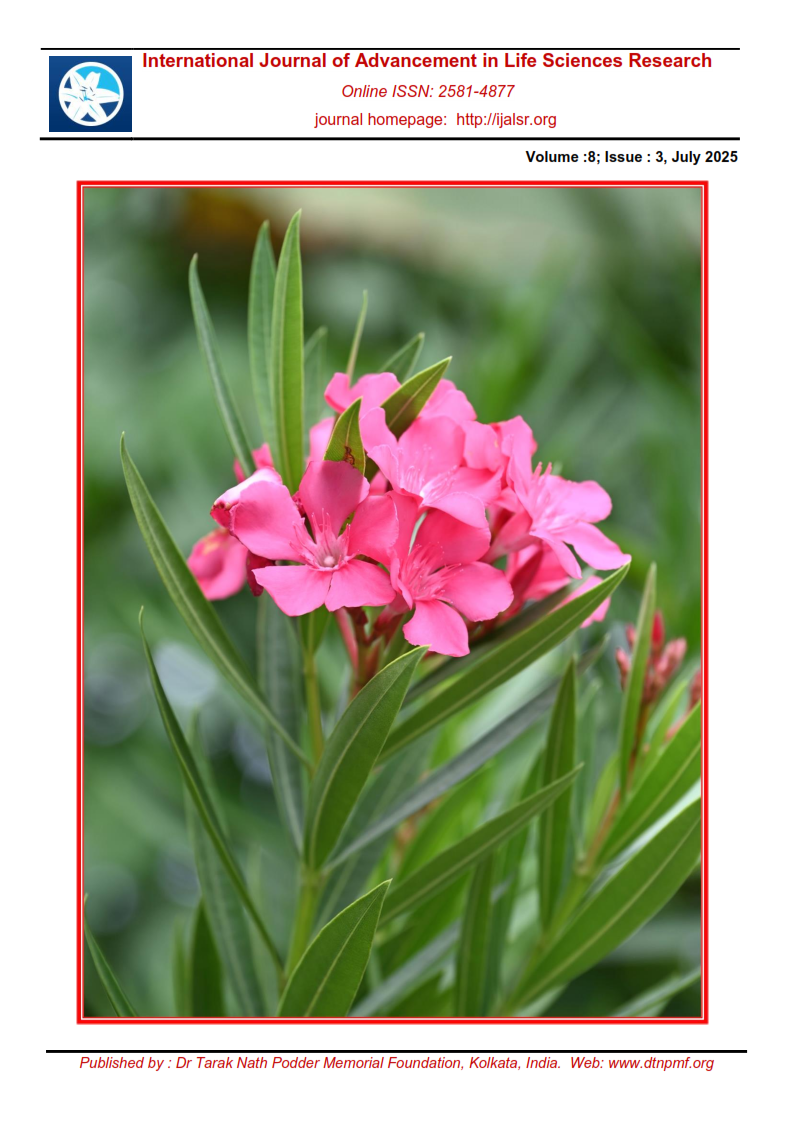Ecological Status of Alternanthera philoxeroides (Mart.) Griseb. and its Associated Plants in the Context of Assam, India
Abstract
Assam, a state rich in biodiversity, is home to Alternanthera philoxeroides (Mart.) Griseb., a fast-growing, seasonal weed that is also consumed as a wild edible. The study revealed that the maximum growth of this weed occurs in the mid-summer months (June to September) in Assam. The plant contains phytochemical parameters like saponin, tannin, protein, flavonoids, steroids, and carbohydrates and is a highly nutritious plant. However, due to limited studies and a lack of proper scientific documentation, the plant remains underutilised. This research aims to provide a comprehensive understanding of the ecological status of the plant in the different study areas under natural ecosystems. The ecological status of Alternanthera philoxeroides (Mart.) Griseb. reflects the habitat, associated plants, and phytosociological parameters in randomly placed quadrates in different locations of Assam. In the present study the quantitative ecological parameters like Relative density (RD), Relative frequency (RF), Basal area (BA), Relative dominance (R dom), Importance Index Value (IVI), Simpson’s Diversity Index (D), Species richness index (Dmg), and Pielou’s evenness index (I) were conducted for Alternanthera philoxeroides (Mart.) Griseb. by using standard methodology. The results showed that the average IVI value of this plant was 122.1, which indicated its high regeneration capacity and greater ecological amplitude among the other associated plant species. From this study, we can provide a comprehensive understanding of the ecological study, which may serve as a valuable reference for future research in this field.
Downloads
References
Fang, X. H., Chen, X. M., Liu, R. L., Zhang, S. H., Gao, J. Q., Dong, B. C., & Yu, F. H. (2024). Effects of alligator weed invasion on wetlands in protected areas: A case study of LishuiJiulong National Wetland Park. Science of The Total Environment, 953, 176230. https://doi.org/10.1016/j.scitotenv.2024.176230
Huang, Y., Huang, Y., Cai, Y., Li, X., & Zhang, J. (2025). Ecological response of Angelica dahurica and its rhizosphere microorganisms to the treatment of Alternanthera philoxeroides extracts. Rhizosphere, 34, 101067. https://doi.org/10.1016/j.rhisph.2025.101067
Jagtap, D. K., Jakhi, P. S., &Kashid, L. M. (2020). Ethno-medicinal study of some plants from Baramati and nearby villages of Pune district, Maharashtra state. International Journal of Agriculture Science and Research, 10(1), 23–32.
Kalita, D., & Phukan, B. (2010). Some ethnomedicines used by the Tai Ahom of Dibrugarh district, Assam, India. Indian Journal of Natural Products and Resources, 1(4), 507-511. Available at: https://nopr.niscpr.res.in/bitstream/123456789/10821/1/IJNPR%201(4)%20507-511.pdf
Lalitha, S., & Vijayalakshmi, K. (2018). Evaluation of vitamins and antinutrients in the leaves of traditional medicinal plant Alternanthera sessilis (L.) R. Br. Ex DC. International Journal of Health Sciences and Research, 8(10), 244–253. Available at: https://www.ijhsr.org/IJHSR_Vol.8_Issue.10_Oct2018/36.pdf
Li, L., & Denich, M. (2024). Niche and interspecific relationship of alligator weed (Alternanthera philoxeroides) after a hundred years’ invasion in central China. Heliyon, 10(20). https://doi.org/10.1016/j.heliyon.2024.e39064
Namsa, N. D., Mandal, M., Tangjang, S., & Mandal, S. C. (2011). Ethnobotany of the Monpa ethnic group at Arunachal Pradesh, India. Journal of Ethnobiology and Ethnomedicine, 7(1), 31. https://doi.org/10.1186/1746-4269-7-31.
National Agriculture and Food Research Organization (NARO). (2025, April 2). Development of herbicide control technology for the invasive alien species alligator weed (Alternanthera philoxeroides) in transplanted rice fields: Effective control of below ground parts with 2 years of management. Available at: https://www.naro.go.jp/english/topics/laboratory/naro/168658.html
Niranjan, M. H., &Prabhurajeshwar, C. (2021). Phytochemical analysis and antimicrobial activity of Alternanthera paronychioides A. St.-Hil. -A smooth Joyweed. Asian Journal of Pharmacy and Pharmacology, 7(4), 156-164.
Puro, K. U., Abedin, S. N., Hussain, Z., Wankhar, J. B., Doley, S., Aochen, C., ... &Deori, S. (2025). Effect of Alligator Weed (Alternanthera philoxeroides) Supplementation on Production Performance, Immune Response and Antioxidant Function of Improved Rural Chicken. Animals, 15(5), 742. https://doi.org/10.3390/ani15050742
Puro, K., Marbaniangm, R., Shilla, H., Khan, S., Hussain, Z., Ramshon, U., Milton, A. P., Das, S., & Ghatak, S. (2025). Exploring the Immunoglobulin Y (IgY) Technology for the Production of Polyclonal Antibodies for Targeted Pathogens of Livestock for Possible Development of Biomolecules in Disease Diagnostics. Acta Scientific Nutritional Health, 9(3), 35-38. Available at: https://actascientific.com/ASNH/pdf/ASNH-09-1497.pdf
Rasool, A., Bhat, K. M., Sheikh, A. A., Jan, A., & Hassan, S. (2020). Medicinal plants: Role, distribution and future. Journal of Pharmacognosy and Phytochemistry, 9(2), 2111-2114. Available at: https://www.phytojournal.com/advertise
Saikia, P., & Khan, M. L. (2011). Diversity of Medicinal Plants and Their Uses in Homegardens of Upper Assam, Northeast India. Asian Journal of Pharmaceutical & Biological Research (AJPBR), 1(3), 296-309. Available at: https://www.academia.edu/3488180/Saikia_P_and_Khan_M_L_2011_Diversity_of_medicinal_plants_and_their_uses_in_homegardens_of_upper_Assam_Northeast_India_Asian_Journal_of_Pharmaceutical_and_Biological_Research_1_3_296_309
Santhan, P. (2020). A field study on Indian medicinal plants. J Med Plants Stud, 8(4), 198-205. Available at:https://www.plantsjournal.com/archives/2020/vol8issue4/PartC/8-3-30-508.pdf
Sharma, N., & Das, G. (2024). Exploring ecological significance and growth of alligator weed, Alternanthera philoxeroides (Mart.) Griseb in Assam, India. Annals of Multidisciplinary Research, Innovation and Technology (AMRIT), 3(2), 29–42. Available at: https://adtu.in/files/current_issue/vol3_issue2/vol3-issue2-article004.pdf
Singh, S. (2023). A review on some medicinal plant species with the most traditional medicinal usage in India. International Journal of Biological Innovations, 5(1), 55-62. https://doi.org/10.46505/IJBI.2023.5103
Snowy Monaro Regional Council (2024). Weed of the week: Alligator weed. Available at: https://www.snowymonaro.nsw.gov.au/News-and-Media/News-articles/
Vogt, G. B., McGuire, J. U., & Cushman, A. D. (1979). Probable evolution and morphological variation in south americandisonychine flea beetles (coleoptera, chrysomelidae) and their amaranthaceous hosts (no. 1589-1593). department of agriculture, science and education administration. Available at: https://agris.fao.org/search/en/providers/122535/records/65ddddbfb766d82b18fa7acb?utm_source=chatgpt.com
Wu, H., Liu, Y., Zhang, T., Xu, M., & Rao, B. (2024). Impacts of soil properties on species diversity and structure in alternanthera philoxeroides-invaded and native plant communities. Plants, 13(9), 1196. https://doi.org/10.3390/plants13091196
Xie, Z. Y., Liu, Z. H., Gu, X. Y., Qin, Y. Y., Du, Y. T., Yan, J., ... & Si, C. (2025). Responses of an invasive plant Alternanthera philoxeroides to cadmium, nutrient availability and water temperature. Aquatic Botany, 199, 103885. http://dx.doi.org/10.1016/j.aquabot.2025.103885

This work is licensed under a Creative Commons Attribution-NonCommercial 4.0 International License.


















 .
.